Author: Jiang Haibo, BlockingNews
Maker is shifting from a classic DeFi protocol to RWA (Real World Assets) direction, and after raising DSR (DAI deposit rate) to 3.49%, finally allowing ordinary users to earn income from US Treasury Bonds through top DeFi protocols.
Recently, MakerDAO has performed excellently in all aspects. According to makerburn.com data, as of June 29, Maker is expected to generate a profit of $73.67 million per year, the highest value in over a year. The current P/E ratio is 8.43, also the lowest in history, making it competitive in DeFi projects.
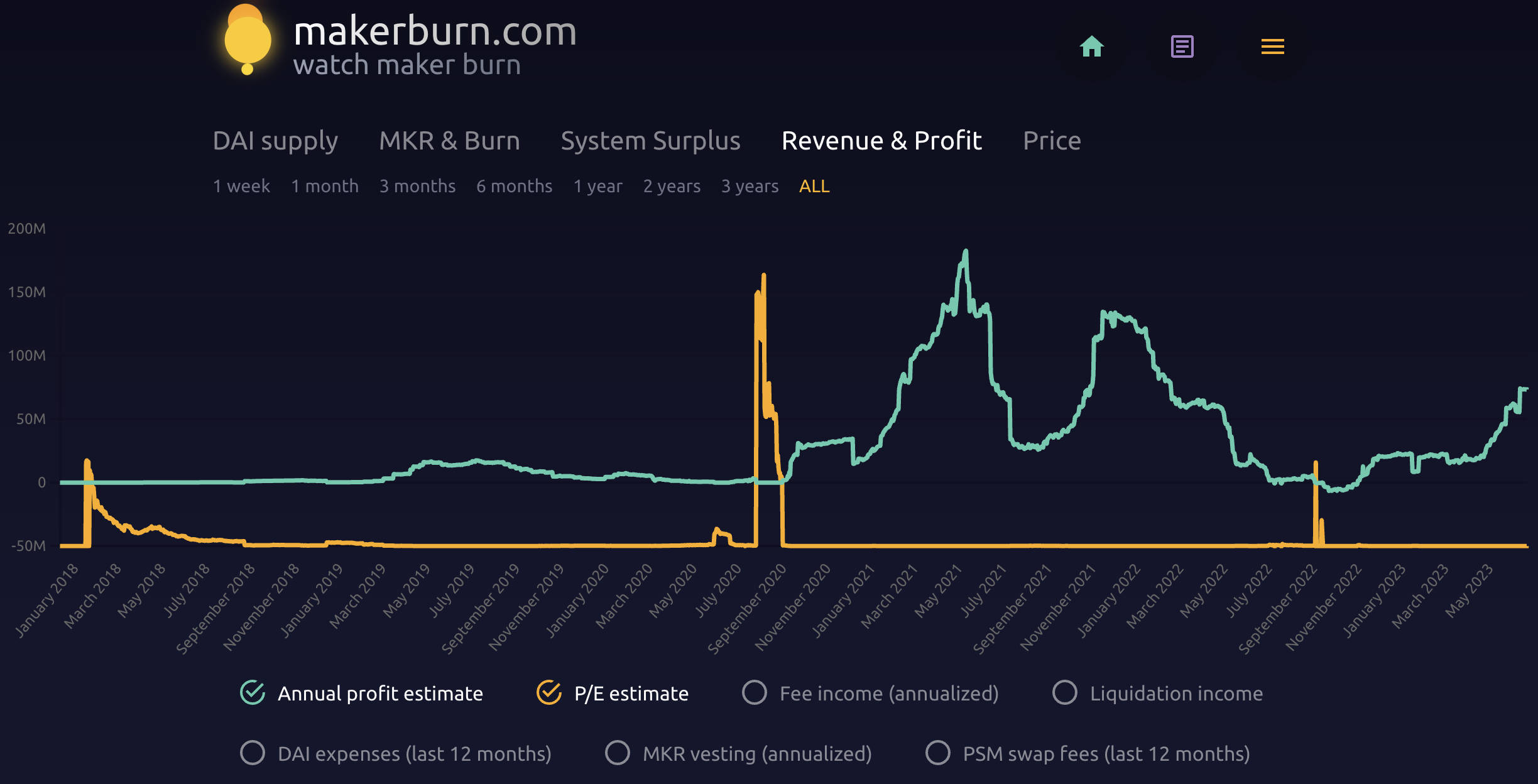
- Adventure Gold DAO launches new L2 network Loot Chain: Can it bring development advantages for the Loot community and AGLD?
- Founder of Azuki responds for the first time to “trust crisis”: underestimated the expectations of the community, and overestimated the ability of the team
- After a double blow to both funding and trust, the holders’ faith collapsed. The latest response from the Azuki team did not win the support of the community.
Various data in Maker
As shown in the figure below, MakerDAO is expected to have a net profit of $73.67 million in a year. Based on current data, Maker’s stable fee (including RWA) income is expected to be $118 million per year, the expenditure of MKR is equivalent to $4.26 million, DSR expenditure is expected to be $6.58 million, liquidation expenditure in the past year is $0.93 million, PSM transaction fee income is $0.15 million, and DAI expenditure is $33.13 million.
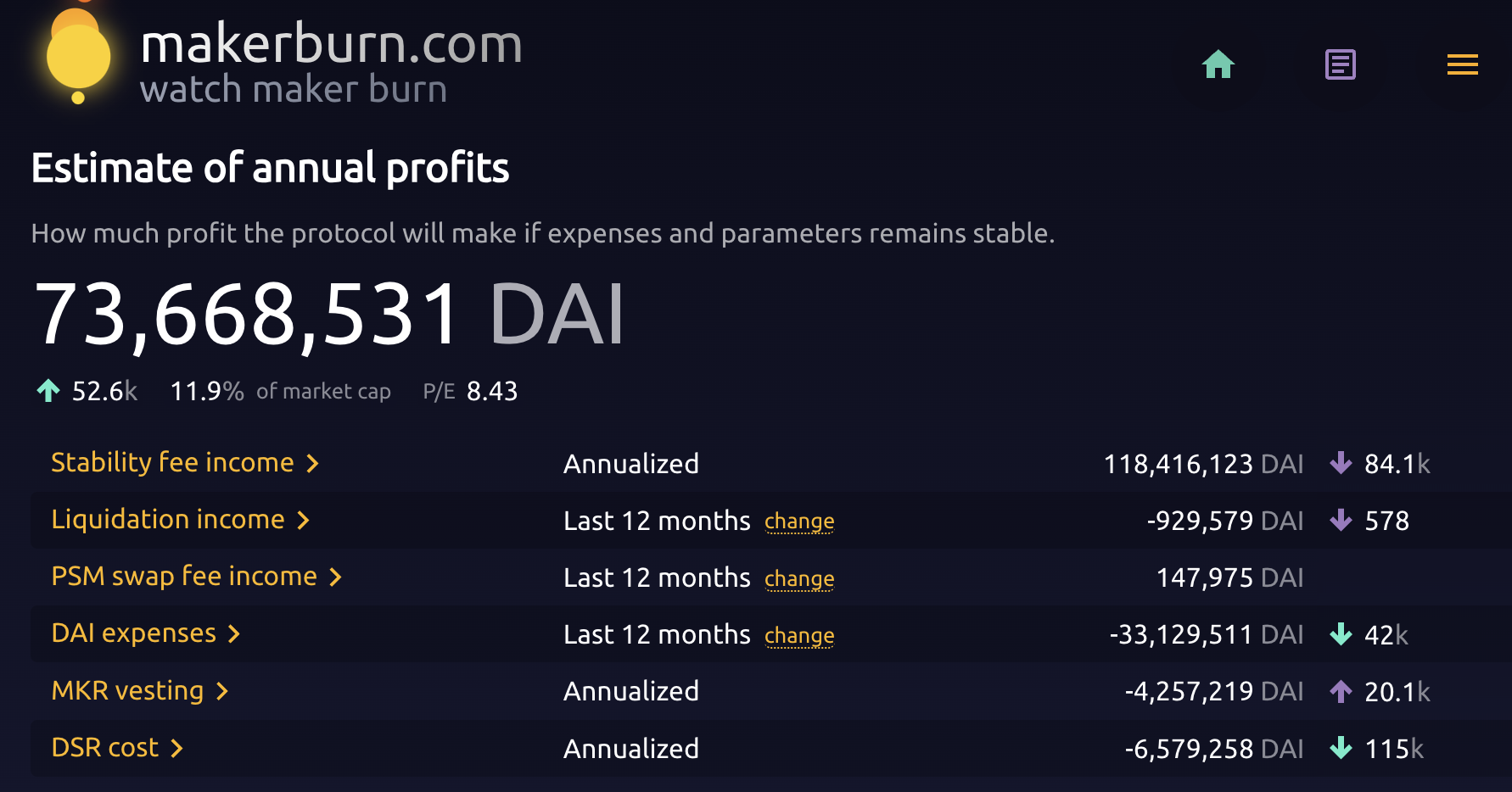
Expected income from RWA and crypto-collateralized lending in Maker are both increasing. On the one hand, Maker’s investment in RWA has been increasing in the past year. When the short-term US Treasury bond yield exceeds 5%, Maker will use more than $2 billion of stablecoin reserves to purchase US Treasury bonds or hold them in other ways that can generate income (Coinbase Custody and GUSD PSM).
On the other hand, the increase in US Treasury bond yields also prompted Maker to raise the minimum interest rate for DSR and crypto-assets such as ETH and stETH pledged loans from 1% to 3.49% on June 19, so the expected income from exceeding collateralized loans of DAI in Maker has also increased recently.
In addition, with the progress of the Maker endgame plan, a series of cost-reduction measures are being implemented. As of June 29, this month’s expenditure of DAI is only $1.9 million, while the average monthly expenditure from March to May this year was about $5 million. Since the DAI expenditure part refers to the actual expenditure in the past year, this data has not yet been reflected in the increase in profits.
The transformation of Maker’s position with stablecoin issuers such as Circle
One year ago, 51.7% of DAI’s issuance came from USDC in PSM, and Maker was criticized for both bearing centralized risk of USDC and not capturing that value. The issuer of USDC, Circle, used the dollar reserves used to issue stablecoins to purchase US Treasury bonds for profit. With the progress of Maker in RWA, this situation has changed, and only 8.8% of DAI collateral is USDC in PSM.
Makerburn’s RWA page shows that DAI minted from RWA collateral has reached 1.42 billion, generating about $53.11 million in annual revenue. In addition, based on RWA014, the $500 million USDC held in Coinbase Custody generates about $13 million in annual revenue, and the $500 million GUSD in PSM generates about $10 million in annual revenue.
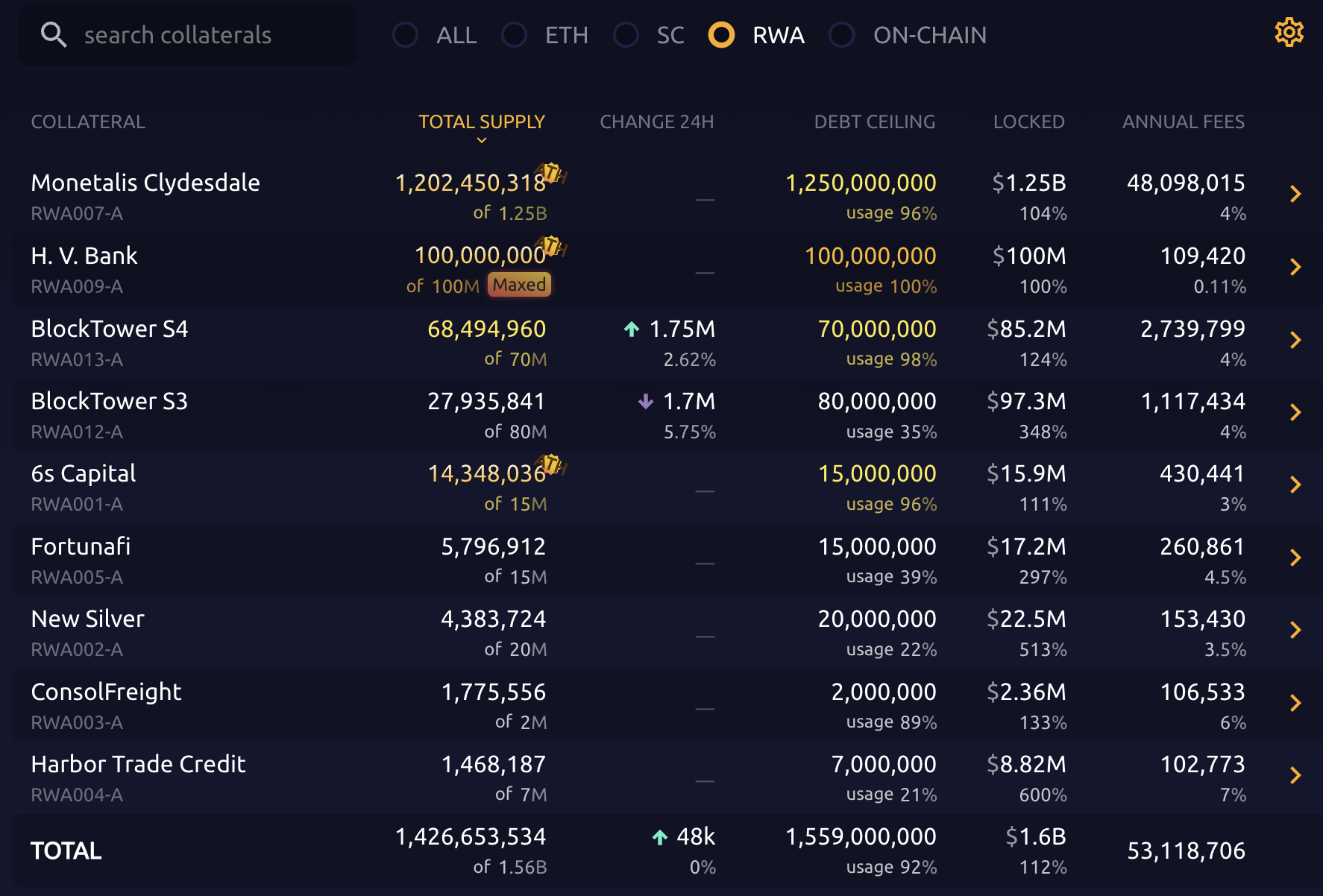
Currently, the unused stablecoins in PSM include $500 million USDP and $414 million USDC. The USDP and GUSD in PSM have reached the set limit of $500 million, and the amount of Maker PSM holdings accounts for 50.5% and 88.5% of the total issuance of these two stablecoins, respectively.
Due to concerns about centralization and security issues, Maker plans to reduce the upper limits of USDP and GUSD in PSM. USDP will be used in RWA015, and the upper limit of GUSD in PSM may be reduced to $110 million.
In its investment in RWA, Maker will first redeem USDC and other stablecoins in PSM for dollars and then use them to purchase US Treasury bonds, a process that has accelerated the reduction in USDC issuance over the past year. Since Maker PSM is already the main holder of USDP and GUSD, reducing or even discontinuing these two stablecoins will have a greater impact on their issuers.
When the short-term US Treasury bond yield exceeds 5%, Maker will raise the DSR to 3.49%, and holders of stablecoins such as USDC can exchange them for DAI at a 1:1 ratio through PSM. Maker will then redeem these stablecoins for dollars to purchase US Treasury bonds for higher returns, which could create a win-win situation.
Repurchase and Burn Rule Adjustment
Recently, in addition to business growth, the MKR governance token of Maker has potential adjustments in repurchase and burn rules.
In the MakerDAO system, MKR not only has governance rights but also serves as a tool to maintain the stability of the system. When the system’s debt exceeds the system surplus, new MKR needs to be sold to make up for the debt; when the surplus funds of the Maker protocol exceed a certain upper limit, the revenue will also be used to repurchase and burn MKR.
There is a “Surplus Buffer” in Maker protocol where the protocol’s profit (DAI revenue from stability fees and liquidation penalties minus all expenses) is kept in reserve. Under the current rules, the MKR buyback and burn process is triggered when the funds in the surplus buffer reach 250 million DAI. The current surplus in the protocol is $70.5 million, and approximately $180 million more profit is needed to initiate the next buyback and burn process.
On June 26, a poll was conducted on the Maker forum to change the current buyback and burn rules under the name “Smart Burn Engine Start Parameters.” The new governance plan will set the upper limit of the surplus buffer to 50 million DAI. When the surplus exceeds this limit, the Smart Burn Engine will automatically buy MKR with DAI on the DAI/MKR trading pair of Uniswap V2. The obtained MKR and DAI will be used to provide liquidity on Uniswap V2, and the LP tokens will be transferred to an address owned by the protocol.
As of June 30th, the poll has ended with a 100% approval rate. If this proposal is approved and implemented in the future execution vote, as the existing surplus already exceeds the new limit, the buyback and burn process will start directly with the surplus purchasing MKR.
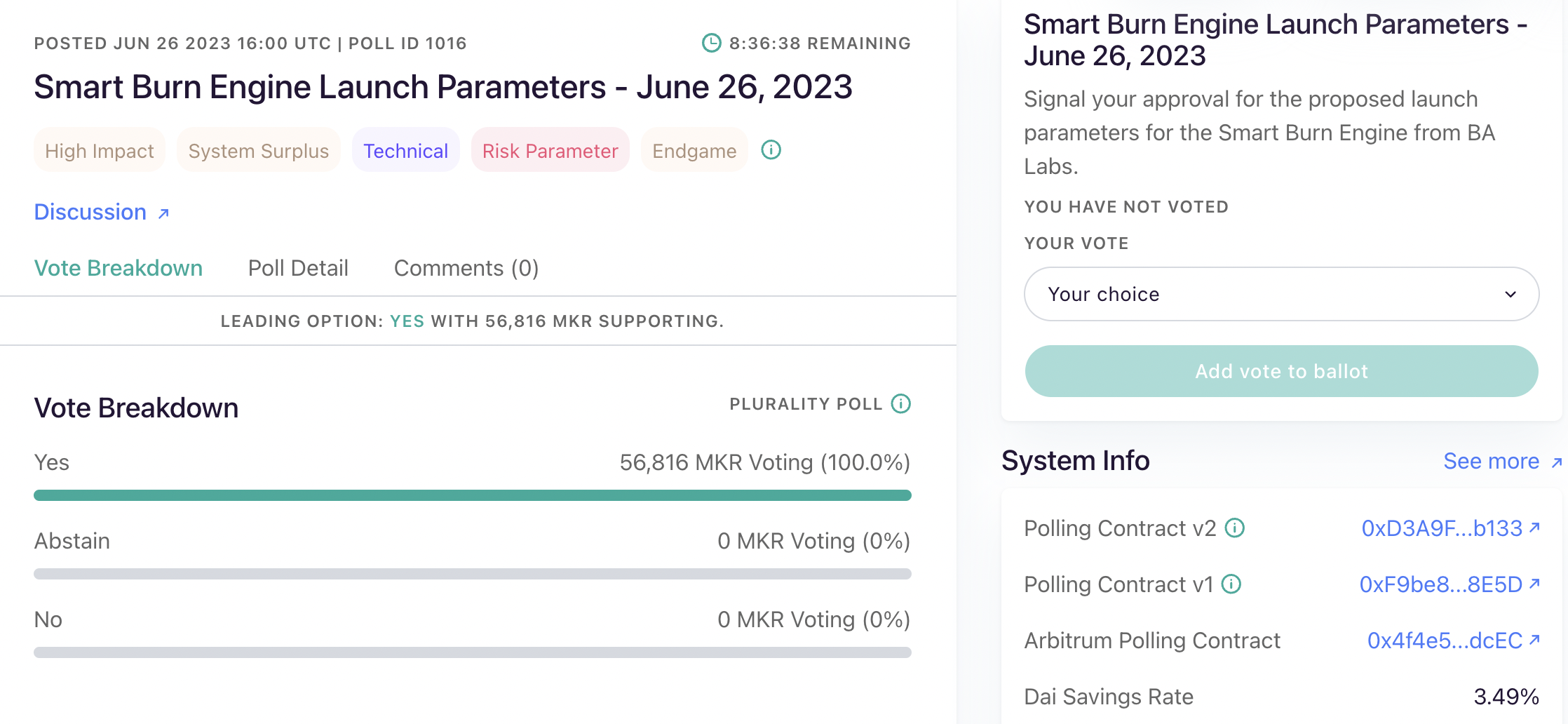
Limitations and Opportunities for Maker’s Development
Maker’s investment in RWA has consumed a large amount of funds in the PSM, leaving little stablecoins remaining. This may be one of the reasons why Maker has significantly increased the DSR, hoping to attract more funds with higher interest rates. However, the increase in DSR may also reduce Maker’s competitiveness in the crypto collateral lending market, limiting its future development.
1. Continuous decrease of DAI supply
According to glassnode data, the supply of DAI has been decreasing for over a year, from 10.3 billion in February 2022 to the current 4.68 billion, a decrease of 54.6%. The size of DAI determines the upper limit of the Maker protocol. DAI minted through over-collateralization provides continuous stability fee revenue for Maker, and most of the reserve in DAI minted through PSM has been used to purchase US Treasury bonds for revenue. The decrease in DAI supply has a negative impact on Maker.
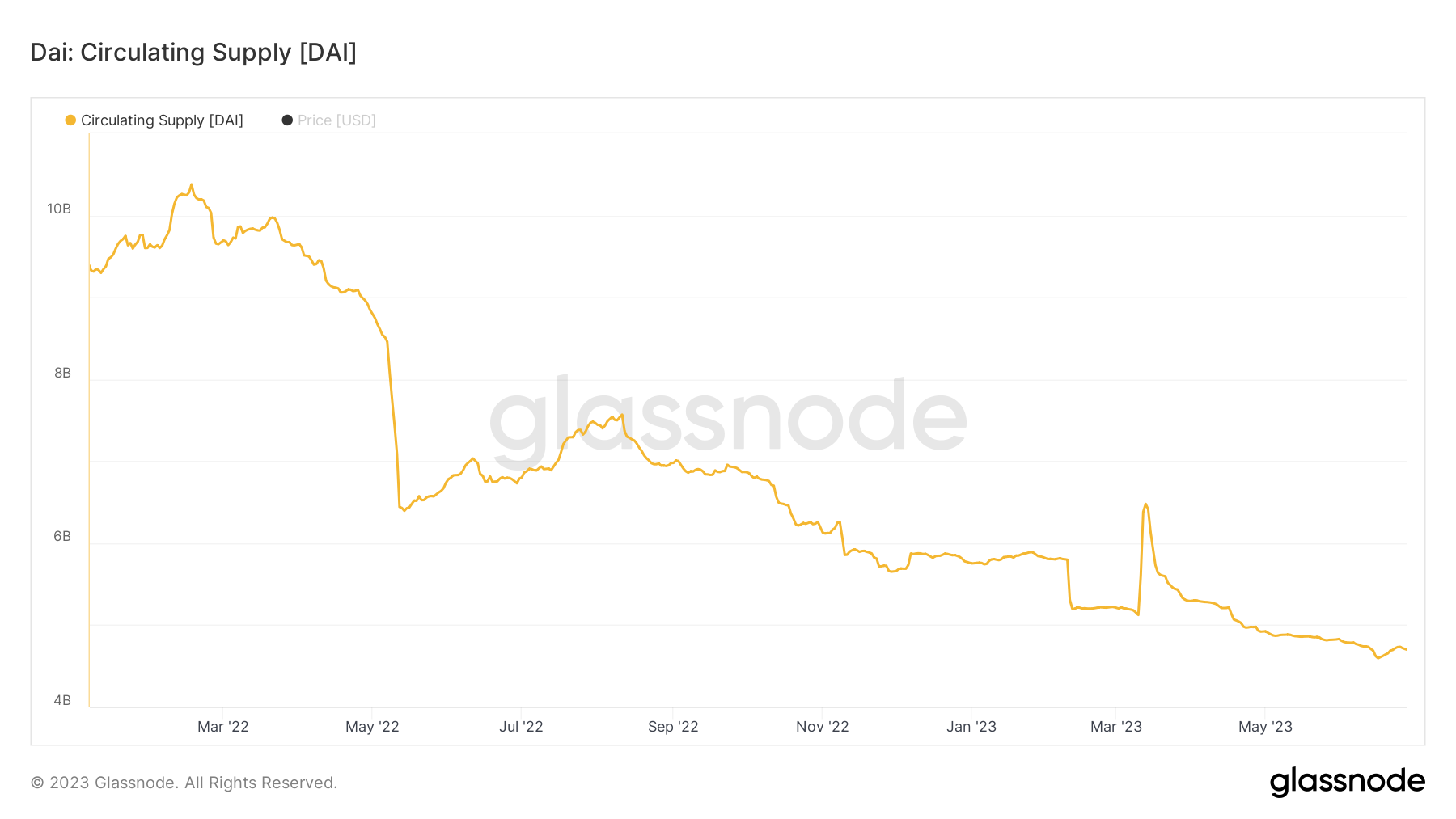
2. Increase in DSR deposits
In addition to minting stablecoins, Maker also shares part of the protocol’s revenue with stablecoin holders through the DSR contract, which is an expense for Maker. After the interest rate of the DSR was raised from 1% to 3.49%, the deposits in the DSR increased from 106 million DAI to the current 188 million DAI, which also led to an increase in this part of Maker’s expenses.
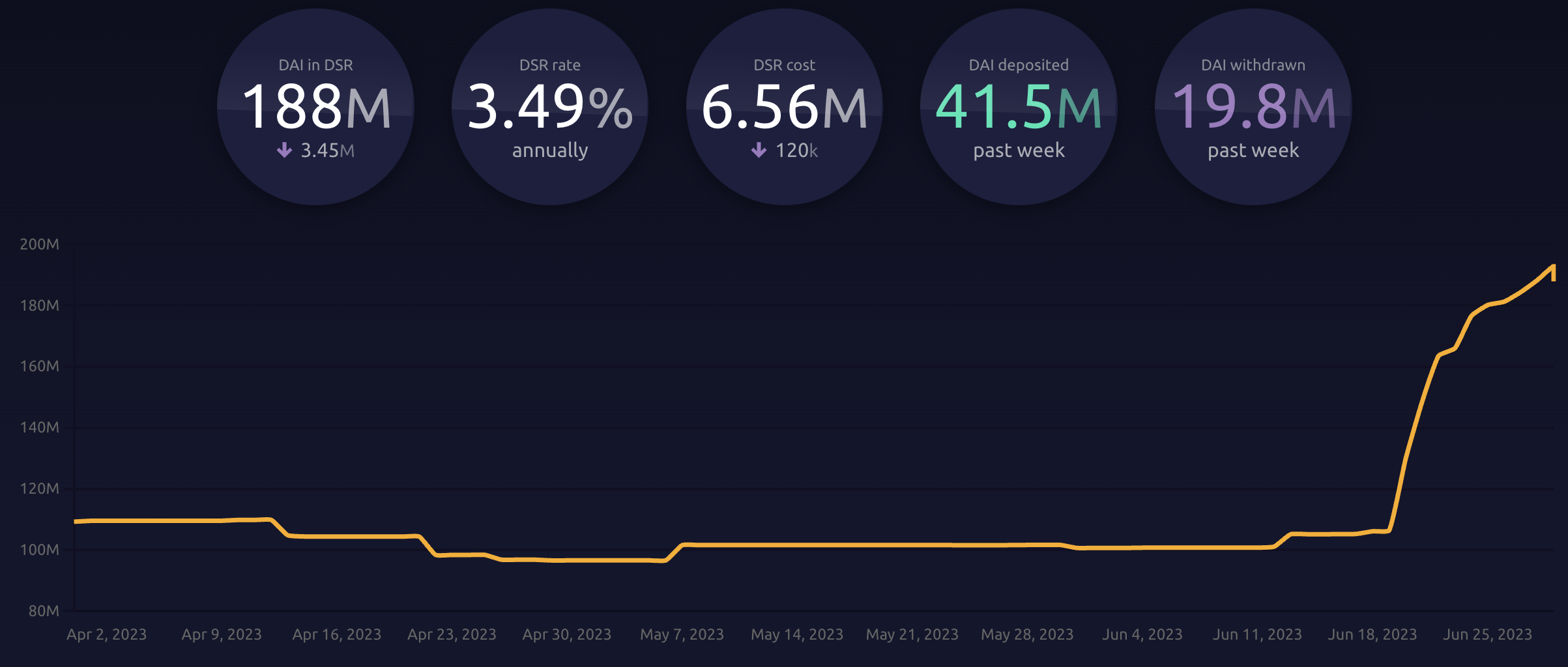
According to data from Dune@steakhouse, 67.9% of DAI is held by external addresses. Etherscan data shows that the address with the most DAI is the PulseX:Sacrifice address controlled by the Pulsechain team. If such DAI holders increase their deposits in the DSR, it will increase Maker’s expenses.
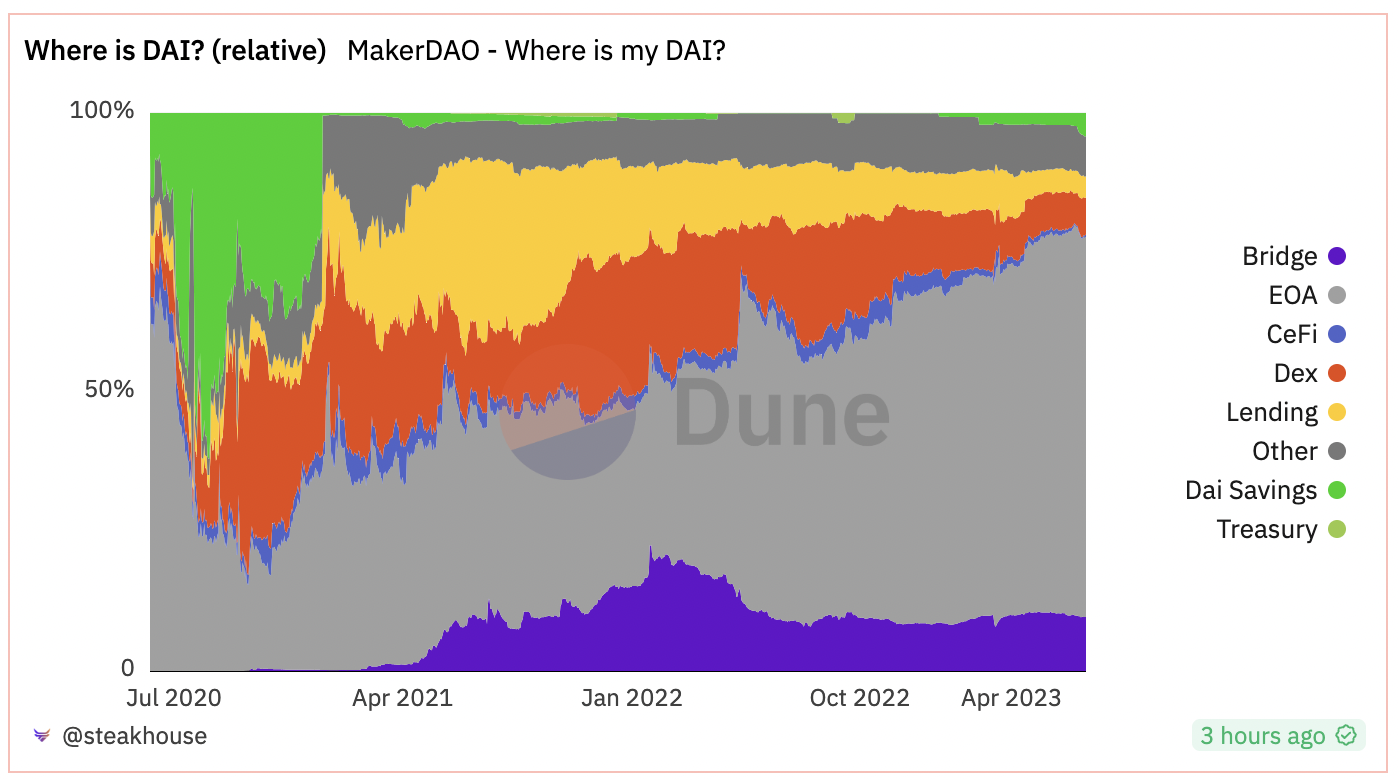
3. Decrease and growth potential of stablecoin reserves
As mentioned earlier, the proportion of DAI minted by USDC through the PSM has decreased from 51.7% to 8.8%, and the remaining amount must also ensure sufficient liquidity for the normal redemption of DAI. At the same time, the amount of funds available for investing in RWA has also decreased significantly, as the amount of USDP and GUSD in the PSM will also decrease soon.
With the increase in the DSR, Maker’s competitiveness in on-chain stablecoin deposits has increased, and it may also attract new users to mint DAI by using USDC through the PSM to obtain higher returns. The deposit interest rates for DAI on Aave are 2.6%, for USDC are 2.83%, and for USDT are 2.69%, all lower than Maker’s DSR interest rate. If the funds used to mint DAI with USDC through the PSM increase, Maker’s funds for purchasing US Treasury bonds will also increase, which will increase the protocol’s revenue, creating a win-win situation.
4. Opportunities brought by liquidity staking
Although the issuance of DAI is decreasing, DAI minted by certain collaterals is still increasing, such as wstETH. In the past three months, the DAI minted by the wstETH-B Vault has increased from 90.87 million to 261 million, and the DAI minted by the wstETH-A Vault has increased from 181 million to 201 million. During the same period, the DAI minted by the ETH-C Vault decreased from 295 million to 290 million, indicating that the new collateral in the wstETH Vault did not come from the funds originally in the ETH Vault, but rather new funds have entered.
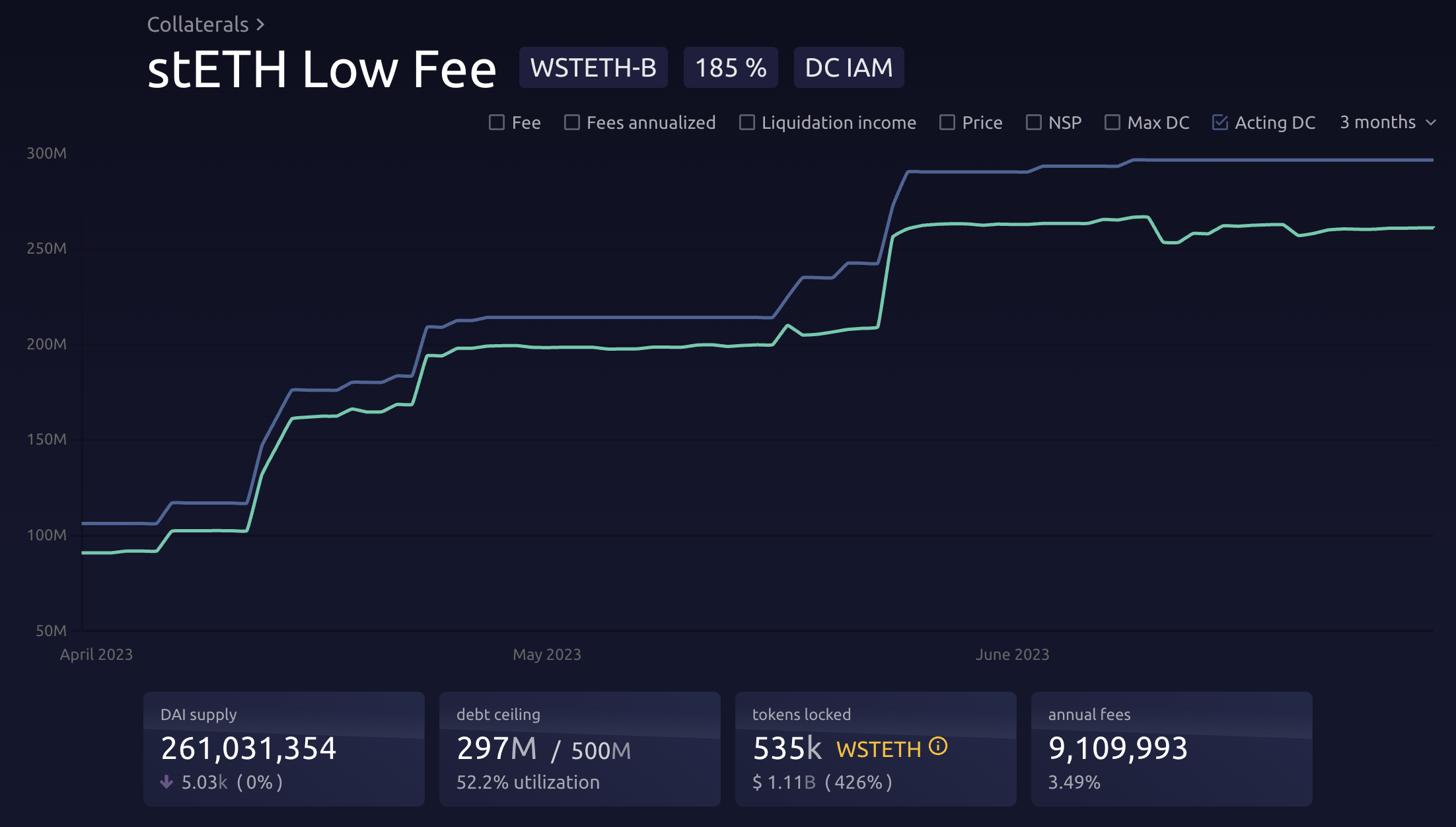
5. Impact of SBlockingrk and other SubDAOs
MakerDAO’s first SubDAO, SBlockingrk, has gone live. According to DeFiLlama, SBlockingrk has a TVL of $15.04 million and is still growing. Due to SBlockingrk’s unique composability, DAI deposited into the DSR (sDAI) can also be used as collateral, further increasing the utilization of funds.
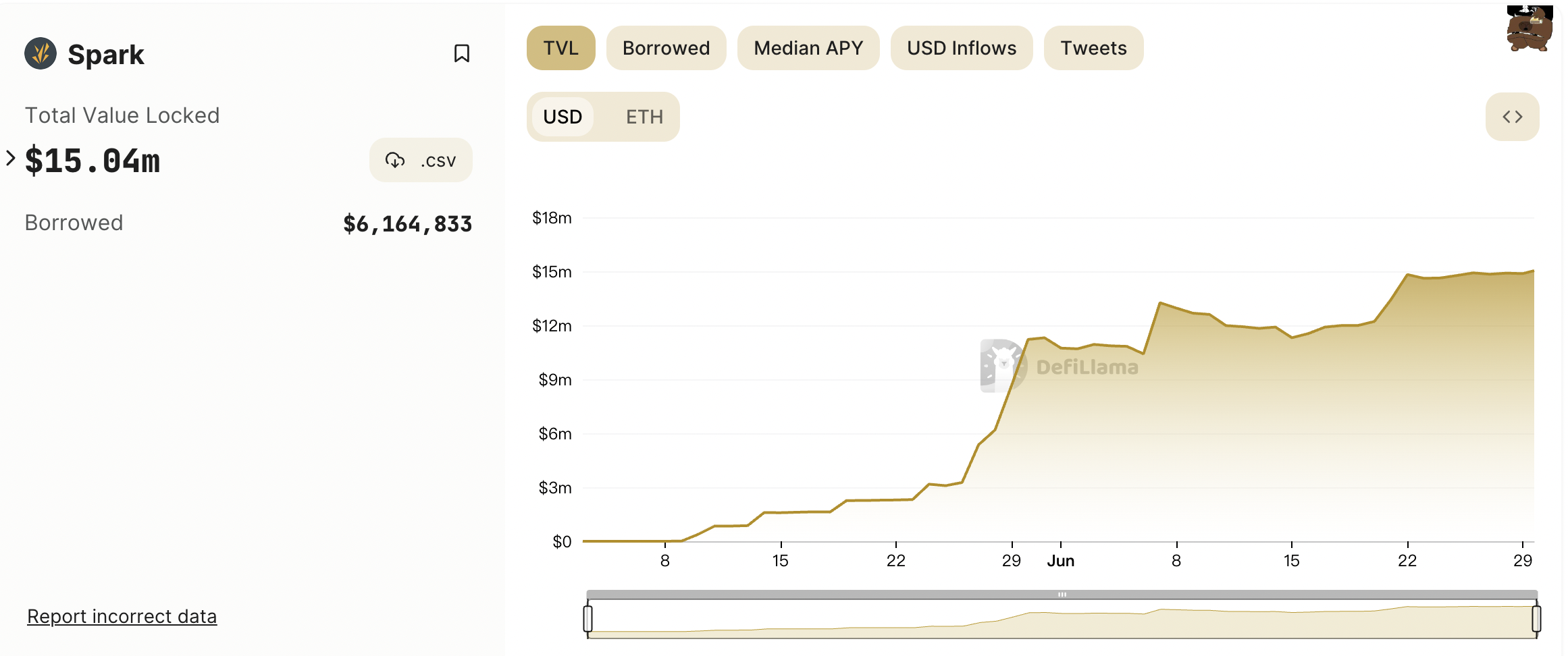
Conclusion
Maker is transitioning from a classic DeFi project to RWA. Recent adjustments to the interest rates of DSR and encrypted collateral loans such as ETH and stETH will further enhance Maker’s competitiveness in RWA and weaken its competitiveness in encrypted collateral loans.
In the process of business transformation, stablecoin issuers such as Circle face significant competition and may need to consider allocating more profits to stablecoin holders. For USDP and GUSD, Maker PSM holds more than 50% of these stablecoins, and adjustments to the PSM ceiling for these two stablecoins will cause significant damage to their issuers.
As the amount of funds available for RWA is limited, this may also be an important reason for Maker’s recent increase in DSR. If this can attract more funds, the investment amount in RWA may continue to grow in the future.
The MakerDAO forum is currently voting on a proposal to change the buyback and burn rules. The current surplus has exceeded the upper limit of the new rules. If the new rules are implemented, buybacks will begin, which will be a positive development for MKR.
Like what you're reading? Subscribe to our top stories.
We will continue to update Gambling Chain; if you have any questions or suggestions, please contact us!